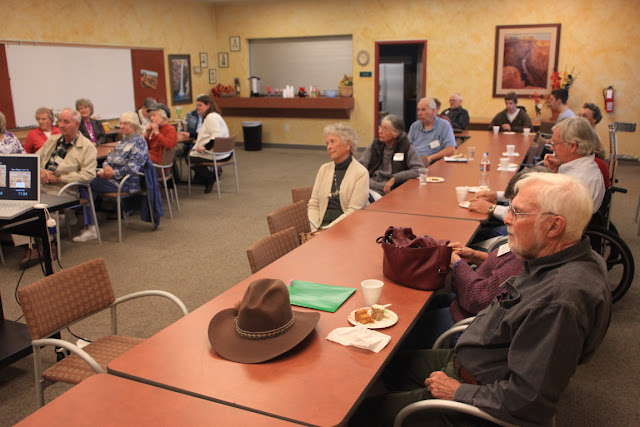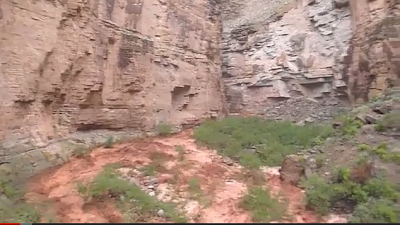Take a look at this group of people
 |
| Participants at the "Workshop on the Origin of the Colorado River", USGS, Flagstaff, May, 2010 |
It represents the entire cohort of experts on planet Earth who know something about the science of the origin of the Grand Canyon. There's about 60 of them, meaning there are not a whole lot of people in the world who regularly concern themselves with the age of the Grand Canyon.
So it was a big deal when the national media reported on the publication of a paper in the journal
Science by researchers
Rebecca Flowers and
Kenneth Farley on November 29. The article reported on evidence they obtained documenting an ancient Grand Canyon of about 70 Ma (million years). The date is more than ten times the age that most of those in the photograph ascribe to the canyon, thus perhaps explaining why the press went hog-wild over a subject that normally lives in the shaded recesses of small tributary canyon. Who would have known that this story would fire up the creative juices of a nation still recovering from the long, drawn out presidential election.
Front page stories appeared in the New York Times, Washington Post, the Los Angeles Times, Huffington Post, the Seattle Times, and Latino Post. The story went viral in just about every small town newspaper in America and who knows how many globally. (My hometown newspaper, the Arizona Daily Sun, ran the mistaken headline, "Jurassic Canyon", obviously trying to play off the Jurassic Park name but missing the time period (Cretaceous) by about 80 million years). Broadcast media even chimed in, with NPR's "
All Things Considered" running a 7-minute segment on the radio and PBS doing similar justice on the television
Nightly Newshour. You can listen and watch these reports
here and
here.
 |
| Zoroaster Temple along the Colorado River in Grand Canyon |
To put it mildly, most scientists who work in this field are not used to the all the attention. So why the hoopla? Perhaps it's because research journals like
Science are not immune to the publicity-seeking payoffs that any media outlet strives for in our information blitzkrieg culture. That's not to say that there is no merit in the research (or the arguments against it). It's not to say that
Science is no longer a well respected journal - it very much is. It's just ironic that the only time the collective national ear is cocked in the direction of Grand Canyon geology is when two respected groups of researchers duke it out in a 'who's right/who's wrong'
sockdolager.
As someone who is knowledgeable about Grand Canyon geology (yes, I am in the picture above but be forewarned that I rarely take sides in such matters, preferring to think that anyone who has come up with an original idea about the canyon's origin is likely to be at least partially right), my own in-box was slammed over the weekend. This in part may be due to the fact that
my book was fortuitously released in a new 2nd edition in late September of this year. Talk about a publicity windfall! Yes, this line of research is contained in the new edition and those in Arizona who have attended my book tour are already aware of its controversial findings.
 |
| Cover of the 2nd edition |
What is the controversy you might ask? First off, it's not an entirely new idea. Flowers and Farley have been working with another Cal Tech researcher,
Brian Wernicke, since at least 2008, when Flowers completed a post-doc under Wernicke at Cal Tech. Wernicke adopted the idea from another "old canyon" geologist, Don Elston, who endured violent opposition to his ideas on the antiquity of the canyon during the late 20th century. There have always been researchers who have found evidence of one kind or another for an "old canyon" since the days of John Wesley Powell. In fact, the idea for a "young canyon" only emerged in 1934 when Eliot Blackwelder published his seminal work, "Origin of the Colorado River" in the GSA Bulletin.
The new theory involves two very complex and complicated laboratory techniques that can reveal when the canyons rocks were brought close to the surface. Using tiny
apatite
crystals collected from the basement rocks in the canyon (Vishnu Schist or Zoroaster Granite), the information yielded two different stories, one for the history of the western Grand Canyon and the other for the eastern canyon, where most tourists see the gorge. The results said that western Grand Canyon (downstream from Lava Falls) was cut to within a few hundred meters (about 1,000 feet) of its present depth
by 70 Ma! The second story reported that the eastern area was the site of a canyon
of similar proportions to the modern canyon by 55 Ma, and cut in Mesozoic rocks now completely eroded away. Incredibly, the western canyon was cut by a river that flowed exactly opposite to the modern Colorado River and the researchers call this the California River. (Get it? - the modern Colorado River goes from Colorado to California, while the ancient California River went from California to Colorado).
 |
| A view of western Grand Canyon, which may have been cut as early as 70 million years ago |
Suffice it to say that those who argue for a young canyon (which is one no older than 6 million years), find the new results tantamount to heresy. Researcher Karl Karlstrom of the University of New Mexico had a four-page rebuttal ready by press time and was quoted as calling the results "ludicrous". And while there may be some legitimate concerns he raises about the use of the technique, I wonder if this kind of response is, in the long run, really beneficial to our science or the public being exposed to it. I believe this is Grand Canyon's moment in the sun, a time to cherish and nurture the opportunity to be heard on the national stage. Perhaps we geologists shouldn't take sides so quickly or denounce our colleagues in such a way. I know, some say this is how science works but don't
we decide how to respond to ideas contrary to our own? Shouldn't we instead take the larger view on the good fortune to be nationally recognized and view the new research results as another possibility for canyon formation that at least deserves to be heard and considered? The Grand Canyon has always had its adherents for an "old canyon". They are a minority for sure but the fact that this idea will not die is evidence enough that something must be there. That is my opinion on the "controversy".
When the Cal Tech group began their study they assumed that the apatite samples would reveal that Grand Canyon's rocks were buried in
unequal amounts of overlying rock - unequal because the canyon today has 5,000 feet of relief and the lower samples should have been buried under more material than those collected from near the top. Most geologists suspect a very subdued surface over the canyon about 70 Ma. The illustration below (from my current lecture) shows red dots where the apatite samples were collected in eastern Grand Canyon. The unequal length of the blue arrows depicts the amount of overlying material they expected to find.
After running the laboratory technique the samples produced surprising results to the researchers. They showed that no matter from what depth the samples were collected, they all appeared to have been buried under
equal amounts of overlying rock. When the tops of the blue arrows are connected here, they reveal a canyon-like topography in eastern Grand Canyon about 70 Ma.
Below is a diagram that shows their interpretation of the data - a gorge of similar proportions was cut into the Mesozoic rocks that are now stripped back to the modern Echo and Vermilion Cliffs.
In my reading of the
Science paper (not light I might add) I observed that the laboratory technique is not as evolved as one might hope for. Some assumptions are made that could result in different outcomes. Still, the technique has potential to help geologists better understand the erosional history of the area and even Karlstrom admits such a possibility. But he also wonders how a canyon could have been carved so early in time and then just sit there relatively unmodified for tens of millions of years. (Don Elston suspected that after being carved, the early canyon was partially filled with sediment and then exhumed only in the last 6 million years).
It's true that the Park will not soon change the widely regarded and useful date regarding the age of the Grand Canyon. What we see today from the canyon's edge is a gorge that has been greatly deepened and shaped in only the last few million years. The evolutionary history of the Colorado River shows that its exact course through the canyon to the Gulf of California was accomplished in only the last 6 million years. But as I make abundantly clear in
"Carving Grand Canyon", most geologists too often
conflate the age of the river with an absolute age for the canyon. For while the Colorado River is definitely no more than 6 million years old, the age of its ancestors or some early incarnation of the canyon need not be so strictly confined.
If we are to make sense of "When did the Grand Canyon form?", we should first ask ourselves, "What defines the Grand Canyon?". Karl Karlstrom and others say that the Grand Canyon must be a feature formed entirely by the modern Colorado River. I'm not so sure. Some aspects of the canyon, with respect to its depth or extent, could pre-date the modern river, having been formed by prior ancestors. Perhaps the question of "When did the Grand Canyon form?" can only be answered by another question: "What constitutes the beginning of the Grand Canyon?"
We are lucky that the world is paying us a visit at this time. Let us attempt to keep the debate civil, respectful, and without harsh words to our fellow geologists. We all seek the truth and each incremental step brings us closer to it. This is part of the process of getting to know a world-class landform that continues to inspire and enchant us all.




























































































